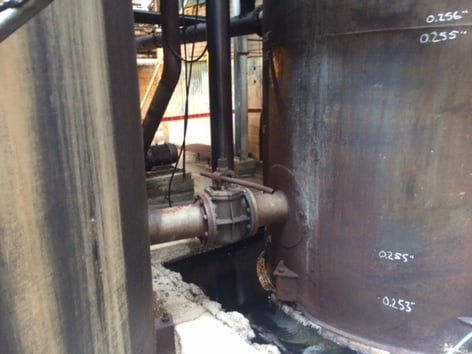Comprehensive Guide to Effective Storage Tank Welding Examination Techniques and Ideal Practices for Quality Control
In the world of container welding, strenuous examination strategies are paramount for protecting architectural integrity and guaranteeing conformity with market guidelines. As we discover these vital parts, it becomes clear that a proactive inspection strategy is not simply valuable, but important for functional success in atmospheres dealing with harmful products.
Value of Tank Welding Assessment

Container welding evaluation works as a preventative measure, identifying possible issues such as fractures, porosity, or improper joint infiltration before they escalate right into severe problems. Normal evaluations not only adhere to industry guidelines and standards yet also improve the long life of the containers, lowering the need for expensive repairs or replacements.

Aesthetic Inspection Methods
Employing methodical visual assessment strategies is crucial for analyzing the quality and stability of bonded joints in tanks. This method functions as the initial line of defense in determining possible problems such as fractures, undercuts, and inadequate infiltration. The examiner should approach the job with an eager eye, making use of ideal devices like multiplying glasses, flashlights, and mirrors to improve presence.
Throughout the examination process, the inspector should assess the weld profile, guaranteeing it follows specified requirements and guidelines (Tank Welding Inspection). This includes examining the bead size, elevation, and combination with the base product. Inspectors must additionally pay very close attention to the bordering locations for indications of thermal distortion or contamination that may influence the weld's efficiency
Paperwork of searchings for is necessary; examiners must videotape any kind of abnormalities, categorizing them by extent for more examination. This methodical technique not only help in prompt problem identification however additionally adds to long-term quality control by making certain conformity with industry requirements. Routine training and calibration of aesthetic evaluation techniques even more enhance the reliability of evaluations, ultimately leading to more secure and a lot more long lasting tank structures.
Non-Destructive Evaluating Methods
Non-destructive screening (NDT) methods are regularly used in tank welding inspections to analyze the stability of welded joints without endangering their structural integrity. These techniques are essential for recognizing flaws such as cracks, gaps, and additions that could cause devastating failings if left unnoticed.
Common NDT techniques consist of ultrasonic testing (UT), which makes use of high-frequency acoustic waves to detect inner problems; radiographic screening (RT), employing X-rays or gamma rays to picture weld frameworks; and magnetic particle screening (MT), which exposes surface area and near-surface interruptions in ferromagnetic materials (Tank Welding Inspection). Liquid penetrant screening (PT) is additionally widely made use of, efficient in spotting surface-breaking issues by applying a fluorescent or shade comparison dye
Each NDT method has its certain applications and benefits, making it vital for assessors to select the suitable technique based on the product and the kind of weld being evaluated. The integration of these NDT techniques right into the examination procedure enhances the total top quality assurance framework, guaranteeing that visit this site bonded containers fulfill safety and performance standards. Ultimately, NDT plays an important function in keeping the honesty and longevity of container frameworks in different commercial applications.

Documentation and Coverage
Making certain comprehensive documentation and coverage throughout container welding evaluations is critical for maintaining conformity with sector criteria and promoting efficient interaction amongst stakeholders. Proper documentation works as an extensive document of inspection tasks, findings, and any rehabilitative activities taken throughout the welding process. This information is crucial not just for top quality guarantee yet likewise for audits and regulative evaluations.

A well-structured inspection report ought to include information such as the day of examination, names of assessors, welding procedures employed, products utilized, and any kind of inconsistencies from developed standards. Additionally, photographs and diagrams can improve the quality of the record, offering aesthetic context to the searchings for. It is also essential to document any type of non-conformities in addition to their resolution, making certain that all stakeholders are notified of prospective dangers and the actions required to mitigate them.
Moreover, maintaining a centralized data source for all examination records permits for simple access and review, cultivating a culture of openness and liability. By prioritizing thorough documents and coverage, organizations can not only promote high quality assurance however additionally reinforce their credibility within the market, ultimately bring about improved safety and security and operational efficiency.
Continuous Enhancement Practices
Continuous improvement methods are vital for boosting the high quality and effectiveness of container welding inspections. Applying an organized method to evaluate and refine inspection methods promotes a society of quality control within the company. One reliable method entails regular training and upskilling of evaluation personnel their explanation to remain abreast of the current welding modern technologies and requirements. This makes sure assessors have the required understanding and abilities to recognize problems accurately.
In addition, utilizing data-driven evaluation permits companies to track examination results, identify fads, and pinpoint areas for enhancement. Using tools such as source analysis can assist in recognizing the underlying concerns bring about flaws, allowing targeted treatments. Additionally, getting comments from assessment groups and stakeholders develops a collaborative environment that motivates cutting-edge solutions.
Integrating innovative technologies, such as computerized assessment systems and real-time surveillance, can considerably enhance the accuracy and rate of assessments. Routine audits of the evaluation processes likewise add to a culture of accountability and constant improvement. Eventually, these continuous renovation techniques not only boost the quality of tank welding examinations however likewise contribute to total functional excellence and consumer complete satisfaction.
Verdict
Finally, reliable container welding evaluation is critical for ensuring the architectural integrity and safety of storage systems, especially those managing company website harmful products. Employing a mix of aesthetic examination strategies and non-destructive screening methods assists in the early identification of flaws, thus preserving compliance with sector standards. Additionally, robust documentation and a dedication to continual renovation enhance high quality assurance methods. Inevitably, these steps add significantly to functional excellence and the prevention of potential security threats.